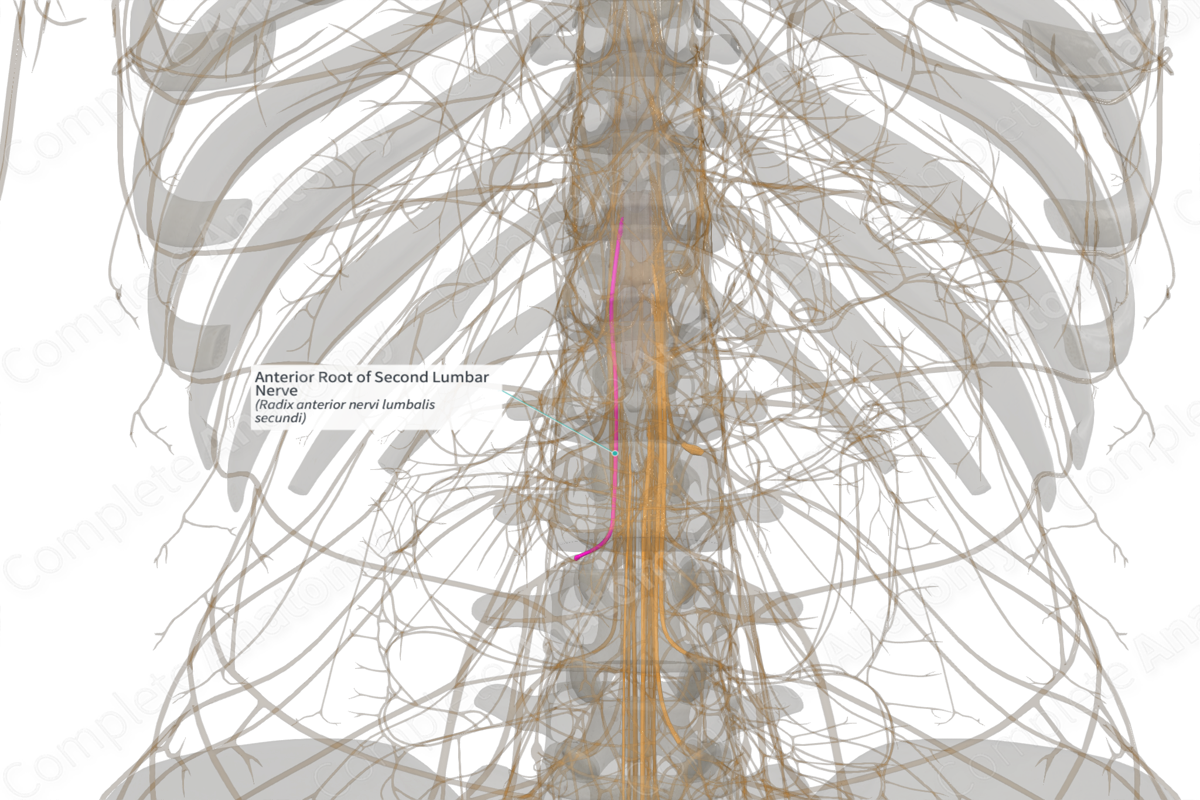
Anterior Root of Second Lumbar Nerve (Right)
Radix anterior nervi lumbalis secundi
Read moreQuick Facts
Origin: Surface of the spinal cord ventral to the ventral horn.
Course: Inferiorly towards the intervertebral foramen between L2 and L3 vertebrae.
Branches: genitofemoral, femoral, and obturator nerves.
Supply: Motor innervation to epaxial muscles, psoas, iliacus, pectineus, sartorius, quadriceps, and adductor muscles, and cremaster muscles in males, or round ligament in females. Sympathetic innervation of hindgut and genitals.
Origin
The anterior root of the second lumbar nerve originates as a series of rootlets that emerge from the ventrolateral surface of the spinal cord. These quickly merge to form the anterior root.
Course
The anterior root runs inferiorly and descends through the vertebral column until it reaches the intervertebral foramen, inferior to the corresponding vertebra. In or just lateral to the intervertebral foramen, the anterior and posterior roots merge to form the spinal nerve.
Branches
The anterior root of the second lumbar nerve sends motor axons to the anterior ramus of the second lumbar nerve. These contribute to the lumbar plexus specifically, the genitofemoral, femoral, and obturator nerves.
Supplied Structures
The anterior root of the second lumbar nerve sends axons to the posterior ramus of the second lumbar nerve, which supply the epaxial muscles of the lumbar region, including erector spinae and the transversospinal muscles.
The anterior root of the second lumbar nerve also sends motor axons to the anterior ramus of the second lumbar nerve. These contribute to the lumbar plexus and the following nerves and their targets.
—The genitofemoral nerve arises from both the first and second lumbar nerves and is almost entirely sensory in females. It may, however, innervate a few vestigial muscle fibers on the round ligament of the uterus in females or the cremaster muscles in males.
—The femoral nerve arises from the second, third, and fourth lumbar nerves. It innervates psoas, iliacus, pectineus, sartorius, and quadriceps muscles (rectus femoris, vastus lateralis, vastus intermedius, and vastus medialis muscles).
—The obturator nerve arises from the second, third, and fourth lumbar nerves. It innervates the adductor muscles (gracilis, obturator externus, adductor longus, adductor brevis, and adductor magnus muscles).
—Sympathetic innervation from the anterior root of the second lumbar nerve targets the hindgut and genital regions.
Learn more about this topic from other Elsevier products


